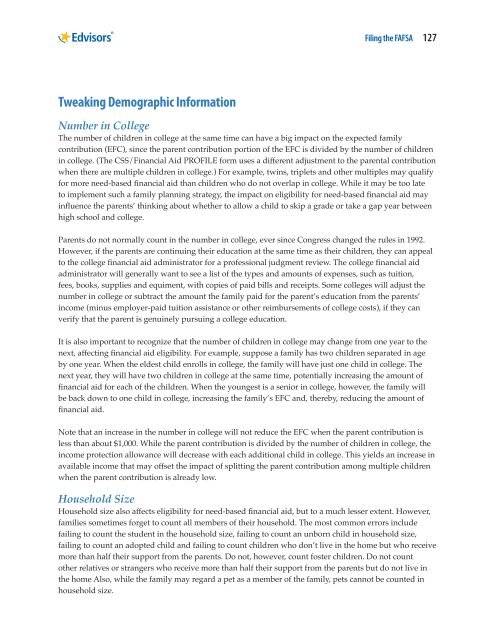filing-the-fafsa-2015-2016-edition
filing-the-fafsa-2015-2016-edition
filing-the-fafsa-2015-2016-edition
You also want an ePaper? Increase the reach of your titles
YUMPU automatically turns print PDFs into web optimized ePapers that Google loves.
Filing <strong>the</strong> FAFSA 127<br />
Tweaking Demographic Information<br />
Number in College<br />
The number of children in college at <strong>the</strong> same time can have a big impact on <strong>the</strong> expected family<br />
contribution (EFC), since <strong>the</strong> parent contribution portion of <strong>the</strong> EFC is divided by <strong>the</strong> number of children<br />
in college. (The CSS/Financial Aid PROFILE form uses a different adjustment to <strong>the</strong> parental contribution<br />
when <strong>the</strong>re are multiple children in college.) For example, twins, triplets and o<strong>the</strong>r multiples may qualify<br />
for more need-based financial aid than children who do not overlap in college. While it may be too late<br />
to implement such a family planning strategy, <strong>the</strong> impact on eligibility for need-based financial aid may<br />
influence <strong>the</strong> parents’ thinking about whe<strong>the</strong>r to allow a child to skip a grade or take a gap year between<br />
high school and college.<br />
Parents do not normally count in <strong>the</strong> number in college, ever since Congress changed <strong>the</strong> rules in 1992.<br />
However, if <strong>the</strong> parents are continuing <strong>the</strong>ir education at <strong>the</strong> same time as <strong>the</strong>ir children, <strong>the</strong>y can appeal<br />
to <strong>the</strong> college financial aid administrator for a professional judgment review. The college financial aid<br />
administrator will generally want to see a list of <strong>the</strong> types and amounts of expenses, such as tuition,<br />
fees, books, supplies and equiment, with copies of paid bills and receipts. Some colleges will adjust <strong>the</strong><br />
number in college or subtract <strong>the</strong> amount <strong>the</strong> family paid for <strong>the</strong> parent’s education from <strong>the</strong> parents’<br />
income (minus employer-paid tuition assistance or o<strong>the</strong>r reimbursements of college costs), if <strong>the</strong>y can<br />
verify that <strong>the</strong> parent is genuinely pursuing a college education.<br />
It is also important to recognize that <strong>the</strong> number of children in college may change from one year to <strong>the</strong><br />
next, affecting financial aid eligibility. For example, suppose a family has two children separated in age<br />
by one year. When <strong>the</strong> eldest child enrolls in college, <strong>the</strong> family will have just one child in college. The<br />
next year, <strong>the</strong>y will have two children in college at <strong>the</strong> same time, potentially increasing <strong>the</strong> amount of<br />
financial aid for each of <strong>the</strong> children. When <strong>the</strong> youngest is a senior in college, however, <strong>the</strong> family will<br />
be back down to one child in college, increasing <strong>the</strong> family’s EFC and, <strong>the</strong>reby, reducing <strong>the</strong> amount of<br />
financial aid.<br />
Note that an increase in <strong>the</strong> number in college will not reduce <strong>the</strong> EFC when <strong>the</strong> parent contribution is<br />
less than about $1,000. While <strong>the</strong> parent contribution is divided by <strong>the</strong> number of children in college, <strong>the</strong><br />
income protection allowance will decrease with each additional child in college. This yields an increase in<br />
available income that may offset <strong>the</strong> impact of splitting <strong>the</strong> parent contribution among multiple children<br />
when <strong>the</strong> parent contribution is already low.<br />
Household Size<br />
Household size also affects eligibility for need-based financial aid, but to a much lesser extent. However,<br />
families sometimes forget to count all members of <strong>the</strong>ir household. The most common errors include<br />
failing to count <strong>the</strong> student in <strong>the</strong> household size, failing to count an unborn child in household size,<br />
failing to count an adopted child and failing to count children who don’t live in <strong>the</strong> home but who receive<br />
more than half <strong>the</strong>ir support from <strong>the</strong> parents. Do not, however, count foster children. Do not count<br />
o<strong>the</strong>r relatives or strangers who receive more than half <strong>the</strong>ir support from <strong>the</strong> parents but do not live in<br />
<strong>the</strong> home Also, while <strong>the</strong> family may regard a pet as a member of <strong>the</strong> family, pets cannot be counted in<br />
household size.


